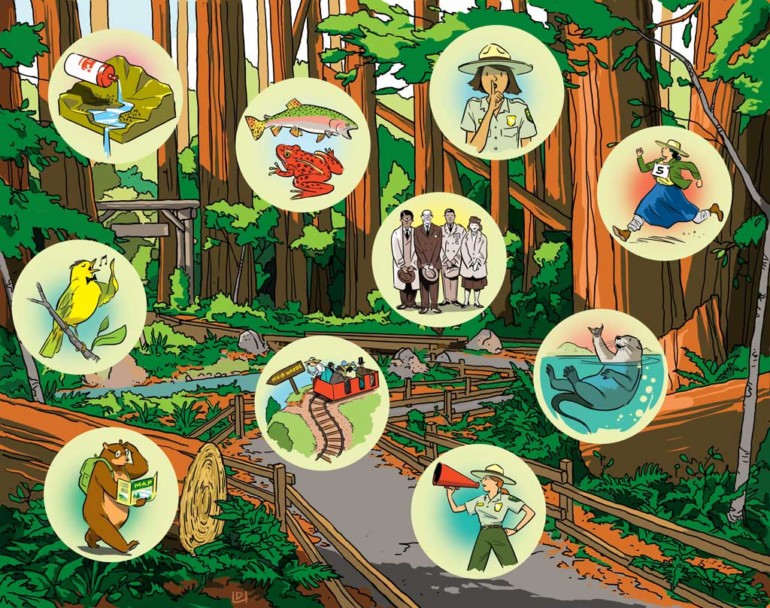Any one of the approximately 1.2 million people who set foot here every year can agree: there’s a magical quality to Muir Woods. Federally protected since 1908, this primeval forest was spared from the massive logging that took place in the 1800s for a simple reason — it was too hard to get to. Congressman William Kent and his wife, Elizabeth Thacher Kent, were instrumental in protecting the roughly 550-acre forest, as was President Theodore Roosevelt, who made Muir Woods an official national monument. To honor Kent, Roosevelt wanted to name the park after the congressman, but went with Kent’s suggestion to name it after conservationist John Muir.
1. Want the real inside scoop on the park? There’s no better way to get it than at one of the rangerled tree talks. These take place at the Pinchot Tree, last about 15 minutes and, thanks to an accessible boardwalk, are open to anyone who wants to learn.
2. In the entrance plaza visitors can find a 3-D bronze topographical map of the Redwood Creek watershed. Find where you are, close your eyes and imagine your journey — pour some liquid from your water bottle to see how it flows down from the top of Mount Tamalpais and all the way to the ocean.
3. In 1945, over 500 delegates from 46 different nations traveled to San Francisco to create what is now the U.N. During the conference they all came to Cathedral Grove in the park to honor President Franklin Delano Roosevelt, who had recently passed away.
4. Cathedral Grove is the first permanent quiet zone in the national park system. Visitors are asked to walk quietly, turn off cellphones and just listen to the forest. Many of the oldest trees live here — respect your elders.
5. Unsurprisingly, the park is teeming with life. Silver, aka coho, salmon and steelhead trout return to their home stream every year to spawn. At Muir Beach, red-legged frogs have made a comeback and share the lagoon there with recently reintroduced western pond turtles.
6. Extensive logging cleared out much of Marin County’s timber as well as the grizzly and black bears, which never returned, but the bear that wandered in from Sonoma County in 2003 served as a reminder that this once was bear territory.
7. The dark, quiet forest is a desirable home for a bevy of bird species. Look out for Wilson’s warbler — the tiny, bright yellow bird makes an impressive journey all the way from South America to nest here.
8. Thanks to conservation efforts, river otters have returned to the park. Visitors can spot the creatures hunting and playing in and around Redwood Creek, especially in the morning when they are most active.
9. Up until 1930, visitors came to the park via the “Crookedest Railroad in the World” and walked downhill into redwoods. Today the railroad grade is still a great hike with a nice climb and fantastic views.
10. The centennial of the Women’s Dipsea Hike is this year. That event was once the only way women could run the course. The first winner, Edith Hickman, donated her trophy to the country’s World War II metal drive.


Kasia Pawlowska loves words. A native of Poland, Kasia moved to the States when she was seven. The San Francisco State University creative writing graduate went on to write for publications like the San Francisco Bay Guardian and KQED Arts among others prior to joining the Marin Magazine staff. Topics Kasia has covered include travel, trends, mushroom hunting, an award-winning series on social media addiction and loads of other random things. When she’s not busy blogging or researching and writing articles, she’s either at home writing postcards and reading or going to shows. Recently, Kasia has been trying to branch out and diversify, ie: use different emojis. Her quest for the perfect chip is never-ending.


